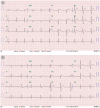COVID-19 Vaccination-Induced Ventricular Fibrillation in an Afebrile Patient With Brugada Syndrome
- PMID: 36325610
- PMCID: PMC9623033
- DOI: 10.3346/jkms.2022.37.e306
COVID-19 Vaccination-Induced Ventricular Fibrillation in an Afebrile Patient With Brugada Syndrome
Abstract
A 43-year-old man presented with cardiac arrest 2 days after the second coronavirus disease 2019 (COVID-19) vaccination with an mRNA vaccine. Electrocardiograms showed ventricular fibrillation and type 1 Brugada pattern ST segment elevation. The patient reported having no symptoms, including febrile sensation. There were no known underlying cardiac diseases to explain such electrocardiographic abnormalities. ST segment elevation completely disappeared in two weeks. Although there were no genetic mutations or personal or family history typical of Brugada syndrome, flecainide administration induced type 1 Brugada pattern ST segment elevation. This case suggests that COVID-19 vaccination may induce cardiac ion channel dysfunction and cause life threatening ventricular arrhythmias in specific patients with Brugada syndrome.
Keywords: Brugada Syndrome; COVID-19 Vaccines; Ventricular Fibrillation.
© 2022 The Korean Academy of Medical Sciences.
Conflict of interest statement
The authors have no potential conflicts of interest to disclose.
Figures



Similar articles
-
Brugada-like electrocardiographic pattern and ventricular fibrillation in a patient with primary hyperparathyroidism.Europace. 2007 Mar;9(3):172-4. doi: 10.1093/europace/eum002. Europace. 2007. PMID: 17344307
-
Syncope after COVID-19 Vaccination in a Young Man with Unmasking Brugada Syndrome.Intern Med. 2023 Apr 15;62(8):1191-1194. doi: 10.2169/internalmedicine.1250-22. Epub 2023 Feb 8. Intern Med. 2023. PMID: 36754404 Free PMC article.
-
Effect of sodium channel blockers on ST segment, QRS duration, and corrected QT interval in patients with Brugada syndrome.J Cardiovasc Electrophysiol. 2000 Dec;11(12):1320-9. doi: 10.1046/j.1540-8167.2000.01320.x. J Cardiovasc Electrophysiol. 2000. PMID: 11196553 Clinical Trial.
-
[Doubts of the cardiologist regarding an electrocardiogram presenting QRS V1-V2 complexes with positive terminal wave and ST segment elevation. Consensus Conference promoted by the Italian Cardiology Society].G Ital Cardiol (Rome). 2010 Nov;11(11 Suppl 2):3S-22S. G Ital Cardiol (Rome). 2010. PMID: 21361048 Italian.
-
Induced Brugada syndrome: Possible sources of arrhythmogenesis.Rev Port Cardiol. 2017 Dec;36(12):945-956. doi: 10.1016/j.repc.2017.06.015. Epub 2017 Dec 10. Rev Port Cardiol. 2017. PMID: 29233646 Review. English, Portuguese.
Cited by
-
Arrhythmias after COVID-19 Vaccination: Have We Left All Stones Unturned?Int J Mol Sci. 2023 Jun 20;24(12):10405. doi: 10.3390/ijms241210405. Int J Mol Sci. 2023. PMID: 37373551 Free PMC article. Review.
-
Genome-wide association study of BNT162b2 vaccine-related myocarditis identifies potential predisposing functional areas in Hong Kong adolescents.BMC Genom Data. 2024 Jun 6;25(1):51. doi: 10.1186/s12863-024-01238-6. BMC Genom Data. 2024. PMID: 38844841 Free PMC article.
-
Adult-Onset Type 1 Diabetes Development Following COVID-19 mRNA Vaccination.J Korean Med Sci. 2023 Jan 9;38(2):e12. doi: 10.3346/jkms.2023.38.e12. J Korean Med Sci. 2023. PMID: 36625174 Free PMC article.
-
Risk of cardiac arrhythmia and cardiac arrest after primary and booster COVID-19 vaccination in England: A self-controlled case series analysis.Vaccine X. 2023 Dec 1;15:100418. doi: 10.1016/j.jvacx.2023.100418. eCollection 2023 Dec. Vaccine X. 2023. PMID: 38090643 Free PMC article.
References
Publication types
MeSH terms
Substances
LinkOut - more resources
Full Text Sources
Medical

